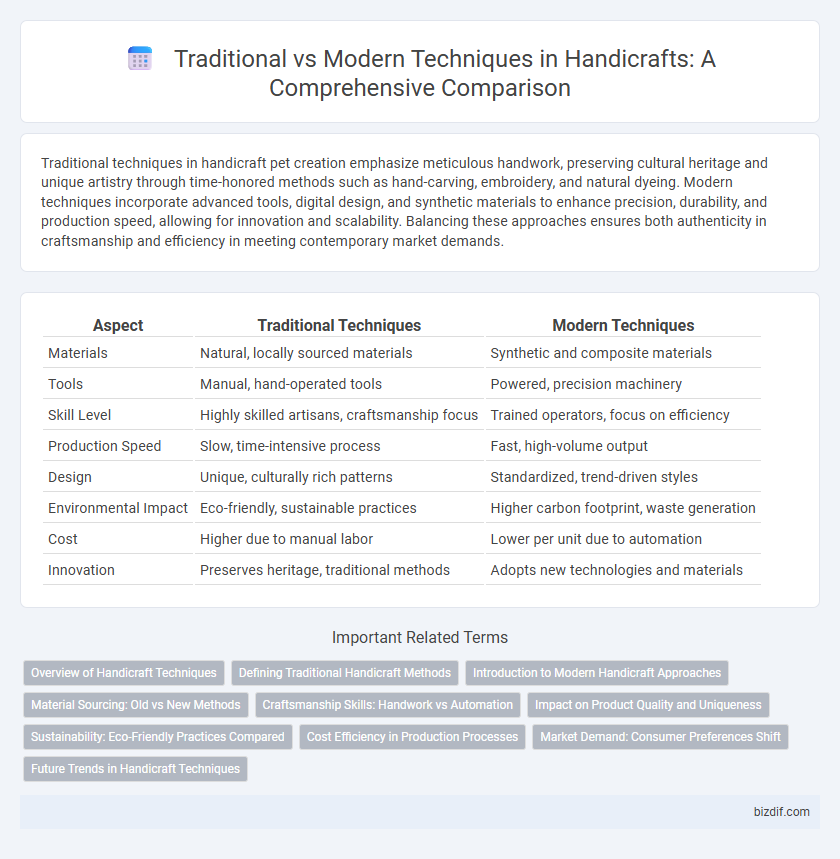Traditional techniques in handicraft pet creation emphasize meticulous handwork, preserving cultural heritage and unique artistry through time-honored methods such as hand-carving, embroidery, and natural dyeing. Modern techniques incorporate advanced tools, digital design, and synthetic materials to enhance precision, durability, and production speed, allowing for innovation and scalability. Balancing these approaches ensures both authenticity in craftsmanship and efficiency in meeting contemporary market demands.
Table of Comparison
| Aspect | Traditional Techniques | Modern Techniques |
|---|---|---|
| Materials | Natural, locally sourced materials | Synthetic and composite materials |
| Tools | Manual, hand-operated tools | Powered, precision machinery |
| Skill Level | Highly skilled artisans, craftsmanship focus | Trained operators, focus on efficiency |
| Production Speed | Slow, time-intensive process | Fast, high-volume output |
| Design | Unique, culturally rich patterns | Standardized, trend-driven styles |
| Environmental Impact | Eco-friendly, sustainable practices | Higher carbon footprint, waste generation |
| Cost | Higher due to manual labor | Lower per unit due to automation |
| Innovation | Preserves heritage, traditional methods | Adopts new technologies and materials |
Overview of Handicraft Techniques
Traditional handicraft techniques emphasize manual skills passed down through generations, such as weaving, carving, and pottery, preserving cultural heritage and unique regional styles. Modern techniques integrate advanced tools, machinery, and digital methods to enhance precision, efficiency, and design complexity in handicraft production. Combining both approaches often results in innovative craftsmanship that respects tradition while embracing technological advancements.
Defining Traditional Handicraft Methods
Traditional handicraft methods encompass time-honored techniques passed down through generations, involving manual skills such as weaving, carving, and pottery without reliance on automated machinery. These techniques emphasize natural materials, cultural symbolism, and artisanal craftsmanship that preserve heritage and local identity. Distinct from modern methods, traditional handicraft prioritizes sustainability and authenticity over mass production and technological efficiency.
Introduction to Modern Handicraft Approaches
Modern handicraft approaches integrate advanced tools such as laser cutters and 3D printers, enhancing precision and design complexity while preserving artisanal quality. Digital platforms enable global collaboration and market access, revolutionizing production and distribution processes. Sustainable materials and eco-friendly techniques are increasingly adopted to align with environmental consciousness in contemporary craftsmanship.
Material Sourcing: Old vs New Methods
Traditional handicraft techniques rely heavily on locally sourced, natural materials such as hand-spun fibers, natural dyes, and wood from sustainable forests, preserving cultural heritage and minimizing environmental impact. Modern methods incorporate synthetic materials and global sourcing networks, enabling mass production and consistent quality but often at the cost of authenticity and ecological balance. The integration of digital tools in material sourcing enhances precision and supply chain efficiency, transforming the way artisans access raw resources worldwide.
Craftsmanship Skills: Handwork vs Automation
Traditional handicraft techniques emphasize intricate handwork that showcases the artisan's skills, patience, and creativity, preserving cultural heritage through meticulous manual processes. Modern techniques utilize automation and advanced machinery to increase production speed and consistency, often reducing the need for extensive craftsmanship expertise. The balance between handwork and automation impacts the uniqueness, quality, and value of handmade products in the contemporary market.
Impact on Product Quality and Uniqueness
Traditional handicraft techniques often enhance product uniqueness through meticulous, handcrafted details that reflect cultural heritage and artisanal skill. Modern techniques streamline production processes, enabling uniform quality and scalability, but sometimes at the expense of individuality and intricate craftsmanship. Balancing these approaches can optimize product quality while preserving the distinctiveness inherent to traditional handiwork.
Sustainability: Eco-Friendly Practices Compared
Traditional handicraft techniques emphasize sustainability through the use of natural, biodegradable materials and time-honored methods that minimize environmental impact. Modern techniques incorporate innovative eco-friendly technologies and renewable resources to enhance efficiency while reducing waste and carbon footprints. Both practices contribute to sustainable craftsmanship by balancing heritage preservation with contemporary environmental responsibility.
Cost Efficiency in Production Processes
Traditional handicraft techniques often incur higher labor costs and longer production times, limiting cost efficiency in large-scale manufacturing. Modern techniques integrate automation and advanced tools, significantly reducing material waste and increasing production speed for better cost management. Balancing handcrafted quality with modern efficiency remains crucial for sustainable and profitable handicraft businesses.
Market Demand: Consumer Preferences Shift
Market demand for handicrafts has shifted as consumer preferences increasingly favor modern techniques that offer durability and innovative designs. Traditional techniques maintain strong appeal among niche markets valuing cultural authenticity and handmade quality. Balancing both approaches allows artisans to meet diverse market needs and sustain economic viability.
Future Trends in Handicraft Techniques
Future trends in handicraft techniques emphasize the fusion of traditional skills with modern technology, such as 3D printing and digital embroidery, enhancing precision and customization. Sustainable materials and eco-friendly processes are increasingly prioritized to meet global environmental standards while preserving cultural heritage. Artisans leverage augmented reality (AR) and virtual workshops to access global markets and collaborate, ensuring the evolution of handicrafts in a digitally connected world.
Traditional Techniques vs Modern Techniques Infographic

 bizdif.com
bizdif.com